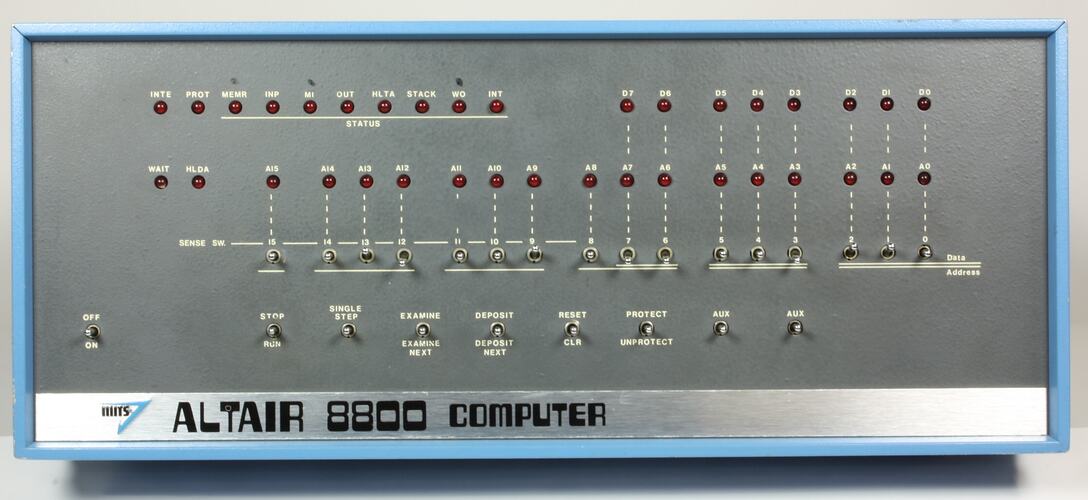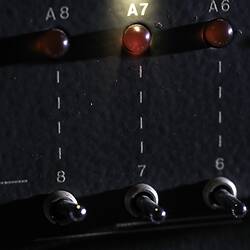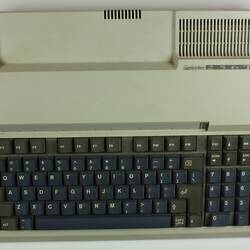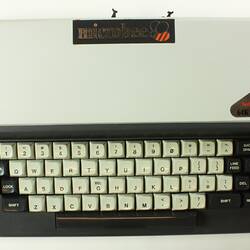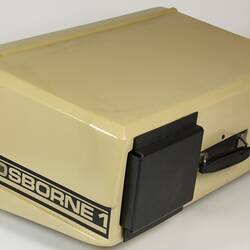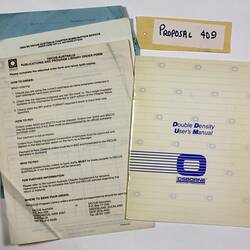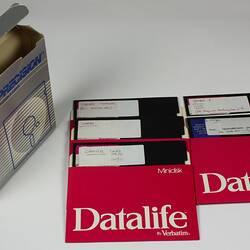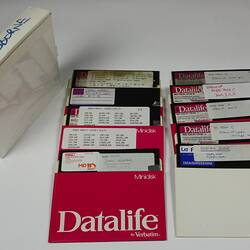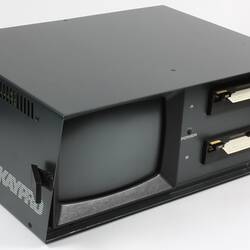The personal computer (PC) has revolutionised business and personal activities, and even the way people talk and think about using information. It is worth pointing out that computers still range in size from very big supercomputers, used for example to model weather and climate change, to incredibly small computers that can fit on smartcards.
In the early 1970s the idea of a computer for personal use was considered by many to be a ridiculous notion. Even so, computer professionals and hobbyists remained committed to developing a personal computer for home and business that was relatively small and cheap.
Museums Victoria currently holds six early personal computers that trace important developments in the history of this remarkable area. There are three computers with separate components (an Altair 8800, a Microbee and an Atari 800) and three early portable computers (a Kaypro, an IBM 'Cubie' and an Osborne II).
Altair 8800
In 1975 the Altair 8800 sparked the phenomenon of the personal computer. The machine was built by a small company, MITS, and was designed to be assembled by hobbyists and professionals and used in homes or at work.
At $US 395 the Altair 8800 computer kit was relatively cheap to buy but required considerable work and skill to assemble. Once complete, the Altair 8800 looked very different to the present day desktop and laptop PCs. It came without a monitor, keyboard, disk drive or programs (software). Instead, users had to write their own programs in binary code by flipping switches on the front panel of the machine, one at a time for every binary digit. The output was read in binary on the light-emitting diodes (LEDs) on the front panel.
The Altair 8800 was powered by an Intel 8080 processor and had only 256 bytes of random access memory (RAM) - about enough to store one paragraph of text. But users remained tolerant. Their enthusiasm spawned computer clubs, stores, newsletters, magazines and conventions.
Atari 800
In 1978 the computer video game company Atari entered the personal computer market with the Atari 400 and 800. Both machines looked very similar to a standard home typewriter. The computer systems were a series of components that, when connected to a television set, functioned as a single system. Other components included a tape deck that functioned as a program recorder, and pre-recorded programs on tape cartridges.
The Atari 800 provided graphics and sound quality never before seen in a personal computer system. It was capable of producing up to 256 colours with built-in player and missile graphics and was compatible with all of the Atari 2600 joysticks, paddles and keypads. The console contained the Central Processing Unit (CPU) and memory bank - 10?000 bytes of read-only memory (ROM) and 8000 bytes of RAM. Software included word processing, financial packages, games and educational titles. Despite its age, the Atari 800 is still one of the most powerful, useful and versatile home computers ever produced.
Microbee
The Microbee was released by the Australian company Applied Technology in 1982. It was one of the first computers introduced into Australian schools, and was a popular training tool for the country's young computer users. Several thousand Microbees were made in the 1980s and sold to users as far away as Sweden.
The Microbee was sold in kit form, and when assembled had the general appearance of a modern-day desktop PC. Its CPU was built into a typewriter keyboard unit, which could be connected to a monochrome monitor for display. Museum Victoria's 256TC model is a more advanced Microbee with larger memory (256K bytes Ram) and includes better graphics, a full size keyboard and numeric keypad along with built in disk drives. The 256TC used the CP/M-80 disk operating system or Microbees' proprietry graphical 'Shell' and was shipped with a bundle of software which included a word processor, disk utilities, serial terminal and the Microworld Basic interpreter. There was a later model which was originally called the 640TC during development and then renamed 'The Matilda' after a naming competition was held. The Matilda was an IBM PC XT compatible design based on an NEC V40 processor and housed in the same case as the 256TC. It ran MS-DOS with EGA level graphics. The Matilda also included special hardware to enable it to run the software that was designed for the Z80 based microbees, such as the 256TC, offering backward compatibility.
Osborne 1
The Osborne 1 was the world's first truly portable computer. It was released in 1980 by computer book publisher Adam Osborne. The computer weighed a substantial eight kilograms and was contained in a large box with a handle.
The Osborne 1 used a Zilog Z-80 microprocessor chip, which was a faster and better clone of the Intel 8080 chip. The tiny 13-centimetre black-and-white screen could display only 52 characters across, but special arrow keys moved the display left and right across a wider 'virtual' screen. The Osborne 1 was plagued with operational problems, but tens of thousands were sold.
Kaypro
The Kaypro II portable computer was released soon after the Osborne and became an instant success. Its appeal lay in its large 23-centimetre monitor and the reliable operating system called CP/M (Control Program for Microprocessors). It had two 5<1/2>-inch disk drives and an impressive 64 000 bytes of RAM. The Kaypro was the first portable to be packaged in a durable metal case.
References:
Freed, L. 1995. The History of Computers. Ziff Davis Press.
More Information
-
Keywords
-
Authors
-
Article types
